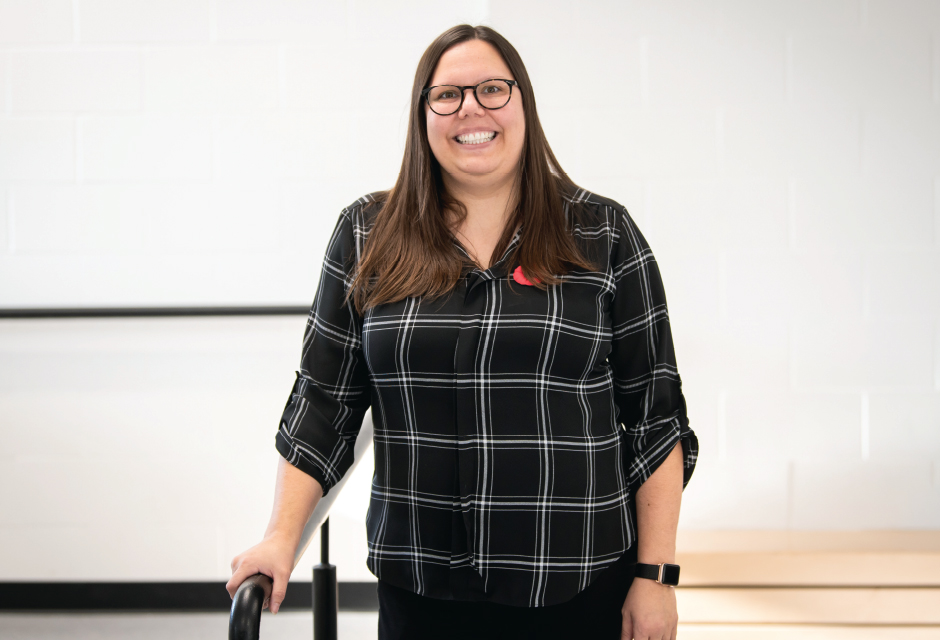Grade 6 Teacher Tawny Lanigan Guides Students Through Identity, Belonging, and Their Relationship to the Land
In her first year at Arthur A. Leach School, Grade 6 teacher Tawny Lanigan brought with her a project that is quickly becoming a meaningful signature of her classroom culture – guiding students in the creation of their own personal land acknowledgements.
Lanigan, who began her teaching career in 2012 in northern Manitoba, has spent most of her career in middle years education. After teaching in Thompson and later in St. Anne, she joined Pembina Trails School Division this year, excited to work closer to home and eager to bring forward the practices that have shaped her teaching philosophy. One of those practices is a project she has now run for three years – helping students explore identity, belonging, history, and land through a reflective learning experience.
Lanigan begins each school year by helping students explore who they are and where they come from. She draws on the Circle of Courage model – belonging, mastery, independence, and generosity – to open conversations about students’ strengths, family backgrounds, and the places they feel connected to.
“It’s a very diverse community in our classroom, including new Canadians,” explains Lanigan. “Which is why the project starts with discussing belonging and identity. Some of this is very new to some of the students.”
This identity work is guided by the Government of Manitoba’s Mamàhtawisiwin Indigenous Education Policy Framework, especially the Honourable Murray Sinclair’s guiding questions: Who am I? Where do I come from? Why am I here? Where am I going?
Students first express these ideas visually by creating word-art portraits filled with the terms they feel represent who they are. Some choose simple shapes while others pick images that reflect their cultures or interests. “It’s neat to see what they find important about themselves,” Lanigan says.
Once students have explored their identities, the class shifts toward understanding the purpose and meaning of land acknowledgements. Together they examine the Truth and Reconciliation Commission Calls to Action, learn which Treaty territory they are on, and explore Indigenous communities using interactive digital maps.
Lanigan provides students with graphic organizers to help them reflect on questions such as: Whose traditional territory is this land? Which communities signed the treaty? How do we use the land? Why do we need to take care of the land? If we don’t care for the land, what could happen?
They then study a variety of sample land acknowledgments, from the Winnipeg Jets to those used by other schools, analyzing what they appreciate and what they feel is missing.
From this, students begin crafting their own acknowledgements, weaving together personal identity, local history, and their relationship with the land.
The results, Lanigan says, range from simple to profound. “Some will say, ‘I use the land to go to the store,’” she laughs. “Others talk about water sources, ceremonies, hunting, or the deeper ways we interact with the land. Everybody’s kind of on their own path with truth and reconciliation.”
Once completed, each student signs up for a day to read their land acknowledgement on the school announcements. Lanigan admits she was nervous about whether Grade 6 students would be willing to present, but “they were all very excited – even the EAL students. Some wanted to take theirs home to practice.”
As the school transitions to its “Live at Leach” announcement format, students now record themselves reading their acknowledgement while Lanigan photographs them. These are shared with the school community, adding a sense of pride and visibility to the work.
The project has also sparked interest among Lanigan’s colleagues. “One teacher told me, ‘I wish I had started when you did,’” Lanigan says. “But it’s never too late. You can start anytime.”
Lanigan plans to continue the project each year, adapting it as new resources and opportunities arise. “Every year it gets better,” she says. “And the students’ land acknowledgements aren’t just something we make and post, they use them, they share them, and they can keep building on them.”
For Lanigan, the project does more than teach curriculum. It sets the tone for the year.
“It absolutely shapes our classroom culture,” she says. The conversations around belonging, identity, and responsibility ultimately lead the class to create their own classroom treaty – a shared commitment to making their learning space positive and welcoming.
“Land acknowledgments are important to continue to build our path to reconciliation,” says Lanigan. “By having students identify their sense of belonging on this land, and the ways they use it, we can figure out how to work together for the future.”


